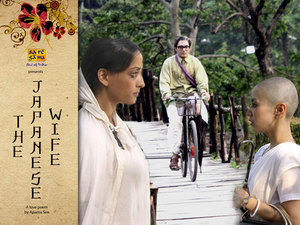Recently, I had this opportunity of watching “The Japanese Wife,” a beautiful and profoundly moving film directed by veteran filmmaker Aparna Sen. The film is a successful adaptation from Oxford-based Bengali Indian author Kunal Basu’s collection of short stories titled The Japanese Wife and Other Stories. Based on the title story of Basu’s book, the film has been released in English, Bengali, and Japanese language. The story of the film centers around a simple, rural arithmetic schoolteacher (played by Rahul Bose) in the interiors of riverine West Bengal, marrying his Japanese pen friend (played by Japanese actress Chigusa Takaku) over letters and staying loyal and committed to her throughout his life, without ever meeting her in person.
The protagonist Snehamoy (Rahul Bose) and Miyage (Chigusa Takaku) are pen friends for long who mutually reciprocate wedding vows over letters. They never actually meet in person but remain loyal to each other as husband and wife. Even though more than fifteen years pass, they are unable to cross the miles and see each other. Irrespective of many odds, nothing changes the love, devotion, and compassion that they have for each other. The odd couple that they are, their strong friendship and bond overcomes all obstacles and stays alive till the end. However, their long distance relationship faces a threat, when a young village widow, Sandhya, (Raima Sen) who is Snehamoy’s aunt’s god-daughter comes to stay at their house with her little son. Snehamoy gradually develops a sympathy for this young woman as she cooks and cares for him, and also an unmistakable fatherly bond with her eight year old son. Nevertheless, Snehamoy’s longing, loyalty, and love for Miyage remains steadfast amid all these circumstances. Miyage falls ill in distant Japan and is diagnosed with cancer. Snehamoy takes an unpaid long sabbatical from his school and does everything to find a cure for her illness. As Miyage’s condition worsens, Snehamoy visits an oncologist in Calcutta to find a proper cure for his wife. On his way back home, disheartened and broken, being unable to get a proper solution to his wife’s illness, he encounters terrible storm and rain and gets severely drenched. Snehamoy gets down with pneumonia and dies untimely, unable to receive proper medication due to flooding in their remote village. The final scene of the film has Miyage arriving in Snehamoy’s village house in a white sari, the symbol of widowhood!
The Japanese Wife depresses us from the very start. The dull and dismal weather conditions in the riverine interiors of West Bengal only adds to the gloom. It is heart-rending to watch and feel the inexplicable love, friendship, and loyalty between two complete strangers living in distant lands. Snehamoy and Miyage’s eternal love saga meets a tragic premature end. They never get to meet face to face and their yearning for each other remains unfulfilled. No amount of obstacle, threat or even their language problem are able to create a rift between them. Such is the solemnity of their relationship! The letters that they write to each other are precious and seem to communicate their deep inner feelings. The exchange of tokens between them, the gifts sent to each other, the huge box of traditional Japanese kites, and of course the hand written letters and long distance phone calls build the beautiful ambience of the film. Again, one cannot miss Snehamoy’s deep bond with the young widow’s son and the discovery of the joys of fatherhood, which he never finds in reality. Snehamoy’s mind being torn between prolonged love and intimacy for his Japanese wife minus the joys of marital bliss and the unspecified understanding with the young widow with the possibility of a domestic life, propels the interest of the film. There are, however, some light and fun moments in the film, where Snehamoy communicates with Miyage in faltering English taking the help of dictionaries. But not for one single moment does language create a barrier for their heart to heart communication. The village kite competition between local rivals also add to the fun element in the film.
Apart from Rahul Bose and Chigusa Takaku, all other actors in the film have done excellent justice to their respective roles. Rahul Bose is brilliant as Snehamoy Chatterjee, and it is a delight to watch him speak in stumbling English. The best moments in the film are perhaps Snehamoy’s interrupted and unsatisfactory conversations with Miyage from a village phone booth, their yearning for letters, Miyage’s gift of engraved silver ring and Snehamoy’s sending her vermillion powder and conch-shell bangles as symbols of traditional Bengali marriage.
The film is an eye-opener in its portrayal of everlasting love and bond between two very different people. It is agonizing to see Miyage visit her husband’s village home clad in a white sari staying his loving and loyal wife till the end, as is Miyage’s unopened letter held in Snehamoy’s hand during his high fever.
The Japanese Wife has received critical appreciation and positive reviews in India and a good draw at the box office. It is a must watch for any film lover!
